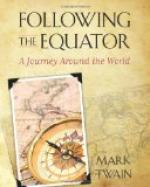By and by there was a result; and I think it may be called the finest thing in Australasian history. It was a revolution—small in size; but great politically; it was a strike for liberty, a struggle for a principle, a stand against injustice and oppression. It was the Barons and John, over again; it was Hampden and Ship-Money; it was Concord and Lexington; small beginnings, all of them, but all of them great in political results, all of them epoch-making. It is another instance of a victory won by a lost battle. It adds an honorable page to history; the people know it and are proud of it. They keep green the memory of the men who fell at the Eureka Stockade, and Peter Lalor has his monument.
The surface-soil of Ballarat was full of gold. This soil the miners ripped and tore and trenched and harried and disembowled, and made it yield up its immense treasure. Then they went down into the earth with deep shafts, seeking the gravelly beds of ancient rivers and brooks—and found them. They followed the courses of these streams, and gutted them, sending the gravel up in buckets to the upper world, and washing out of it its enormous deposits of gold. The next biggest of the two monster nuggets mentioned above came from an old river-channel 180 feet under ground.
Finally the quartz lodes were attacked. That is not poor-man’s mining. Quartz-mining and milling require capital, and staying-power, and patience. Big companies were formed, and for several decades, now, the lodes have been successfully worked, and have yielded great wealth. Since the gold discovery in 1853 the Ballarat mines—taking the three kinds of mining together—have contributed to the world’s pocket something over three hundred millions of dollars, which is to say that this nearly invisible little spot on the earth’s surface has yielded about one-fourth as much gold in forty-four years as all California has yielded in forty-seven. The Californian aggregate, from 1848 to 1895, inclusive, as reported by the Statistician of the United States Mint, is $1,265,215,217.
A citizen told me a curious thing about those mines. With all my experience of mining I had never heard of anything of the sort before. The main gold reef runs about north and south—of course for that is the custom of a rich gold reef. At Ballarat its course is between walls of slate. Now the citizen told me that throughout a stretch of twelve miles along the reef, the reef is crossed at intervals by a straight black streak of a carbonaceous nature—a streak in the slate; a streak no thicker than a pencil—and that wherever it crosses the reef you will certainly find gold at the junction. It is called the Indicator. Thirty feet on each side of the Indicator (and down in the slate, of course) is a still finer streak—a streak as fine as a pencil mark; and indeed, that is its name Pencil Mark. Whenever you find the Pencil Mark you know that thirty feet from it is the Indicator; you measure the distance, excavate, find the Indicator, trace it straight to the reef, and sink your shaft; your fortune is made, for certain. If that is true, it is curious. And it is curious anyway.




